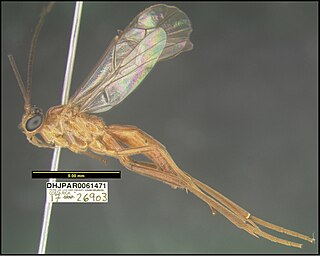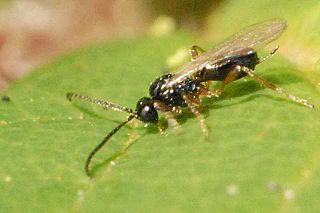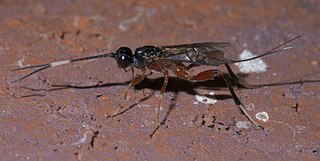
The Ichneumonidae, also known as ichneumon wasps, ichneumonid wasps, ichneumonids, or Darwin wasps, are a family of parasitoid wasps of the insect order Hymenoptera. They are one of the most diverse groups within the Hymenoptera with roughly 25,000 species described as of 2016. However, this likely represents less than a quarter of their true richness as reliable estimates are lacking, along with much of the most basic knowledge about their ecology, distribution, and evolution. It is estimated that there are more species in this family than there are species of birds and mammals combined. Ichneumonid wasps, with very few exceptions, attack the immature stages of holometabolous insects and spiders, eventually killing their hosts. They play an important role as regulators of insect populations, both in natural and semi-natural systems, making them promising agents for biological control.

The Braconidae are a family of parasitoid wasps. After the closely related Ichneumonidae, braconids make up the second-largest family in the order Hymenoptera, with about 17,000 recognized species and many thousands more undescribed. One analysis estimated a total between 30,000 and 50,000, and another provided a narrower estimate between 42,000 and 43,000 species.

The Aphidiinae are a subfamily of tiny parasitoid wasps that use aphids as their hosts. Several species have been used in biological control programs of various aphids.

Microgastrinae is a subfamily of braconid wasps, encompassing almost 3,000 described species, with an estimated 30,000–50,000 total species. This makes it one of the richest subfamilies with the most species of parasitoid wasps.

The Cheloninae are a cosmopolitan subfamily of braconid parasitoid wasps.

Agathidinae is a subfamily of braconid parasitoid wasps. Some species have been used in biological control programs.

Adeliini is a tribe of braconid wasps within the subfamily Cheloninae. Until 2016, Adeliini was classified as a separate subfamily, the Adeliinae. They are small, stout-bodied braconids that parasitize the larvae of leaf-mining moths. Despite being widespread, they tend to be rare in entomological collections.

The Cenocoeliinae are a subfamily of braconid parasitoid wasps.

The Macrocentrinae are a subfamily of braconid parasitic wasps. Several species have been used in biological control programs.
Apozyx is a genus of braconid parasitic wasps with only one species, Apozyx penyai. It is the only genus in the subfamily Apozyginae. This subfamily was originally proposed as a separate family by Mason in 1978.

The Homolobinae are a subfamily of braconid parasitoid wasps.
Dirrhope is the only extant genus in the subfamily Dirrhopinae of braconid parasitoid wasps. Dirrope was included in the Microgastrinae until 1984. Specimens of this genus have been found fossilsed in amber dating from the Cretaceous period.

Blacini is a tribe of braconid Parasitoid wasps.

Meteorinae is a subfamily of braconid parasitoid wasps; however, since 2015, most scientists have treated this clade as the Tribe Meteorini in Euphorinae. Several species have been used in biological control programs. The name for this group comes from the pupal stage, which, in species attacking Lepidopteran hosts, hangs suspended from a long thread of silk.
The Ichneutinae are a subfamily of braconid parasitoid wasps.

Helconinae is a subfamily of braconid wasps in the family Braconidae.
Trachypetinae is a subfamily of the parasitic wasp family Braconidae. The family Trachypetidae was erected in 2020 for three rare Australian genera of large parasitoid wasps formerly included in the Braconidae, but was reduced to a subfamily in 2022.
The Acampsohelconinae are a subfamily of braconid parasitoid wasps. Extant members of this subfamily were previously included in the Helconinae, Blacinae, or Sigalphinae. The four genera included are †Acampsohelcon, Afrocampsis, Canalicephalus, and Urosigalphus.
The Amicrocentrinae are a subfamily of braconid parasitoid wasps. Members of this subfamily were previously included in the Macrocentrinae.

Sigalphinae is a subfamily of braconid wasps, containing 8 genera and less than 50 described species.














